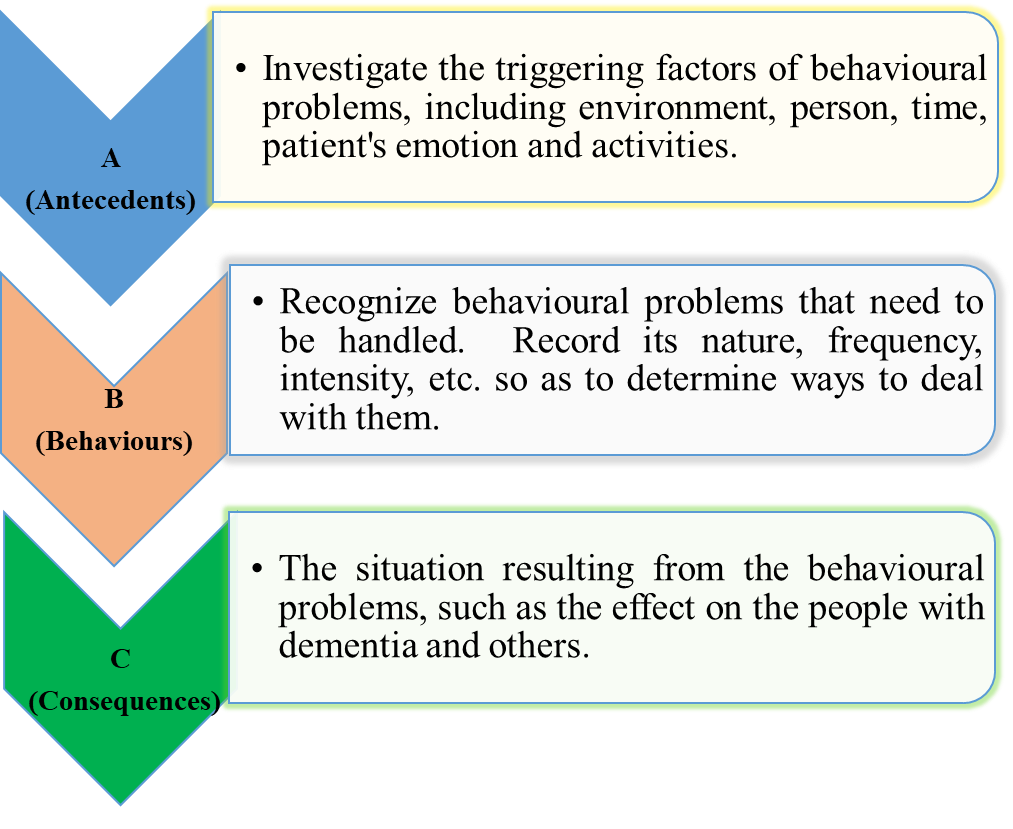Dementia - Managing behavioural problems
Introduction
According to studies, about 90% of the people with dementia experienced different levels of behavioural and psychological problems ( Behavioural and Psychological Symptoms of Dementia or “BPSD” ). “BPSD” refers to people with dementia having symptoms of thought and behavioural problems as disease progresses. The severity of behavioural and psychological problems may vary according to the different types or stages of dementia, causing overwhelmed and heavy stress to carers.

Diagram 1
Causes of behavioural problems
Inappropriate behaviours may be caused by the following factors:


Diagram 2
ABC model
When the inappropriate behaviours or negative emotions of people with dementia are affecting themselves, their families or even old-aged home's routine and residents, we have to manage them timely. Before managing them, we should understand the antecedents of these behaviours and to prevent them from happening again.

Diagram 3
We should first try to understand people with dementia from their perspectives and angles. Then, we have to analyse the reasons and consequences of the problem and set treatment goals and objectives. For frequently occurring behaviours, it is helpful to record the characteristics of those behaviours (e.g. the intensity, duration and format) to determine ways to deal with them.
Non-pharmacological interventions ( from three aspects: person, environment and activities to manage behavioural problems )
Person
- Effective communication skills
When carers are talking to patients, they should maintain a friendly, kind, gentle, and patient attitude. Try to encourage them to respond, pay attention to their verbal cues and their actual feelings. Avoid verbal conflict and avoid challenging their memory. - Attention diversion
We can divert their attention through patient's familiar people, objects, pictures, photos, or their acceptable and favorable activities to relieve their stress and calm them down.
Environment
- Environmental improvement
Try to establish a personalised environment for people with dementia by providing appropriate stimulus; for example, use clock and monthly calendar to provide reality-oriented information, display patient's favorite bouquets or potted plants to soothe them with familiar smells, and control lighting and sound, etc.
We can also make good use of the environment to help dealing with some of the behavioural problems. For example, we can keep the environment safe for them to walk, use bright colour labels / signs to create visual clues, etc.
Activities
- Therapeutic activities
We should arrange therapeutic activities for people with dementia regularly. It can be in different settings such as individual, small group or large group activities. Some examples for therapeutic activities include "reality-orientation", "cognitive training", "reminiscence”, "multisensory stimulation" and "social activities".
Gentle reminders to carers
✓Understand patient's existing ability which includes physical, cognitive and self-care in order to understand their needs
✓Keep in mind that patient's behaviours are caused by the disease itself and it may not reflect their actual intentions or feelings. They do not meant to be incorporative intentionally or trouble making.
✓Always be aware of their harmful behaviours. When carers face with such behaviours, they must keep calm and try to stop them as soon as possible.
✓Try to agree with supervisors, frontline staff and carers to use the same attitude and method to handle behavioural problems (either strict or loose). Report and evaluate the effectiveness of methods used regularly.
✓Use of positive rewards to encourage positive behaviours.
✓Be understandable and patient in accepting them. Maintain a sense of humour and use flexible approach to solve problems.
✓Learn from previous experience and try to think of different solutions. Refer to health-care professionals if necessary.
Related Audiovisual and Booklet Package(s):
Practical Tips for Carers - Dementia Care
Practical Tips on the Carers of Elders with Moderate to Severe Dementia - Dementia Care II
